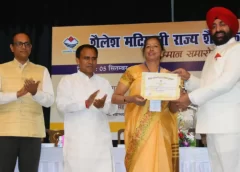Dehradun- 21 April 2022- The day initiated with over 150 students from seven schools participating in the Craft Workshops with Master Craftsmen. The activities included Pottery, Jute Doll Making, Balloon and Face Art, Mandana Art, Block Painting, Kite Making, and a Uttrakhand based art form called Apan. The Montessori School, Doon International School, The Horizon School, Jaswant Modern School, The Oasis School, The Latika Roy Foundation, and Raja Ram Mohan Roy Academy participated in the activities conducted. The evening lit up with Sumedha Sengupta, a renowned Odissi dancer from Kolkata. Sumedha Sengupta, started her journey at the tender age of five under the guidance of the famous Guru Shri Giridhari Nayak at his ashram. After learning from many other gurus of Odissi, she has opened a dance school in Ranchi, named “Angan”, where she trains pupils in this beautiful traditional dance form.
Sumedha believes in the universality of art and music. She feels that exposure to the various art forms nourishes the soul of an artist and takes their skill to a higher level, and nurtures the community towards harmony. She has choreographed many dance demos of Rabindranath and also directed “Urmila” for the Ministry of Culture. She also works as an Indira Gandhi centre for culture and arts official under the Ministry of Culture.
The Odissi performance started with the pad in the praise of lord Jagannath. The lay, taal and abhinay together formed an imagery. Her next presentation was Shankaravarnam Pallavi composed in ek taal by Guru Kelucharan Mohapatra in raag Shankvarni with Shri Saroj Kumar Mahati on the vocal, Shri Javed on sitar and Praful Mangraj playing Pakhwaj. The music composer of the performance was Pandit Bhubaneswar Mishra. The next performance was a depiction of Aardhanarishwar composed by Guru Kelucharan Mohapatra.
The Manganhar are a community found in the desert of Rajasthan, India; mostly in the districts of Barmer and Jaisalmer and Sanghar in the bordering province of Sindh in Pakistan. They along with the Langha community, are known for their folk music. They are the groups of hereditary professional musicians.The Manganhars are the folk musicians of the Thar desert. Their songs are passed on from generation to generation as a form of oral history of the desert.Their instruments are traditional and still are used in performances.
Kamaicha, is a unique bowed instrument of 17-strings made of mango wood, its rounded resonator is covered with goatskin. They also use the khartaal, a kind of castanet made of teak and Dholak. In other presentations of the cultural program, Langa Manganiyar folk music and Kalbelia dance were presented by Pandhe Khan International Folk Artists Forum of Rajasthan. Pandhe Khan’s group singers were Mushtaq Khan, Shay Kahani and Din Mohammad while Siddiq Khan on vocals, Thanu Khan on Khadtal and Deu Khan on Dholki. The program started with “Kesariya Balma Padharo Mhare Des…” and then Sufi Kalam “Dama Dum Mast Qalandar” was presented.
The Kalbelia are a snake-charmers tribe from the Thar Desert in Rajasthan, India. The dance is an integral part of their culture and is performed by men and women. They are the snake catchers. They are also called Sapera and Jogira, Gattiwala and Poogiwara. Hence, the dance movements and the costumes of their community bear a resemblance to those of the serpents. They live a nomadic life. The Kalbelia dance, performed as a celebration, is an integral part of Kalbelia culture. Their dances and songs are a matter of pride and a marker of identity for the Kalbelias, as they represent the creative adaptation of this community of snake charmers to changing socio-economic conditions and their own role in rural Rajasthani society.
The male participants play musical instruments, such as the pungi, a woodwind instrument traditionally played to capture snakes, the dufli, been, the khanjari – a percussion instrument, morchang, khuralio and the dholak to create the rhythm on which the dancers perform. Kalbelia songs are based on stories taken from folklore and mythology and special dances are performed during Holi. The Kalbelias have a reputation for composing lyrics spontaneously and improvising songs during performances. These songs and dances are part of an oral tradition that is handed down generations and for which there are neither texts nor any training manuals. In 2010, the Kalbelia folk songs and dances of Rajasthan were declared a part of its Intangible Heritage List by the UNESCO.
The next performance by the same Pandhe Khan International Folk Artistes Forum was Kalbelia dance in which Jashoda Saperan and Naina Saperani presented their dance. REACH was established in 1995 in Dehradun and has continued to organize the Virasat Festival ever since. Their aim is simply to preserve the value and essence of Indian art, culture and heritage and to bring these cultural values to the masses. Virasat has been instrumental in reviving many rural arts which were once on the verge of extinction due to a lack of an audience. The festival has played an essential role in preserving and reviving our village’s traditions, music, dance, crafts, painting, sculpture, theatre, storytelling, traditional cuisine, etc. and bringing them into practice in these modern times, because of which our classical and contemporary arts have started being recognized once again. Virasat 2022 promises to mesmerize you and take you on an unforgettable and enthralling musical and cultural journey.



